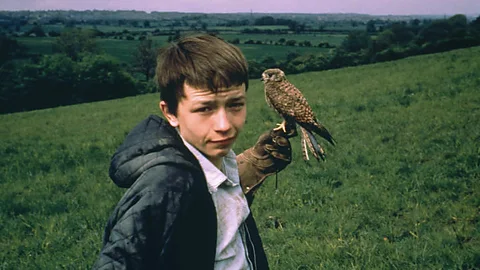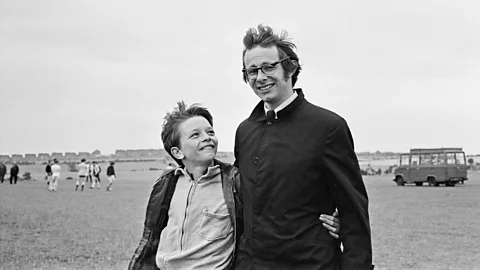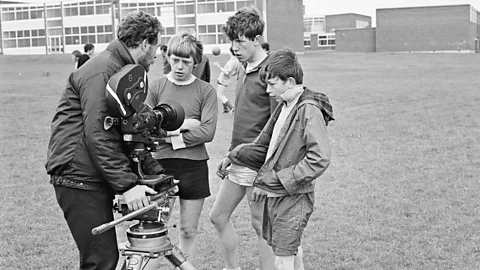 Alamy
AlamyFirst released in November 1969, Ken Loach’s social-realist tale of a boy who adopts a kestrel still resonates and has become a timeless classic of British cinema.
When director Ken Loach and producer Tony Garnett first screened Kes for British film executives in the autumn of 1969, they were confident that they’d created something authentic and important.
Based on Barry Hines’s 1968 novel A Kestrel For a Knave, and written by Loach, Hines and Garnett, Kes tells the story of Billy Casper (Dai Bradley), a South Yorkshire teenager from a dysfunctional family who struggles at school. He finds a new lease of life when he adopts and trains a recently hatched kestrel he names Kes.
But Loach and Garnett’s excitement over the film was short-lived. When the screening finished, the executives told them that the accents were so heavy and Kes was such a regional story that it would premiere in the Yorkshire city of Doncaster and have only a limited run in UK cinemas. “There was this idea that it was a local film for local people,” explains Prof David Forrest, who teaches Film and Television Studies at the University of Sheffield and recently wrote a BFI Film Classics book on Kes.
 Getty Images
Getty ImagesLoach and Garnett were adamant that the executives were wrong. They insisted that Kes was a film for everybody and that the “central image of Billy and the bird was poetic and had a universal relevance and appeal”, Forrest tells the BBC. In order to make sure that the drama was given the release it deserved, Garnett turned to his friends in the national press for help. “He mounted a counter campaign,” says Forrest. “The likes of The Guardian and The Times wrote that they were being stopped from watching the film. So, obviously, when you say to someone that something is banned, it makes it more attractive.”
When Kes had a wider release at the end of March 1970, it quickly drew acclaim from critics. Writing in The Spectator, Penelope Houston called it a “genuine, resolute little film”. Roger Ebert wrote that it was “one of the best, the warmest, the most moving films of recent years” when it finally reached US cinemas in 1973. It also became a word-of-mouth hit across the UK, and picked up two awards at the 1971 Baftas, with Colin Welland landing the best supporting actor gong for his portrayal of Mr Farthing, and Bradley being named the most promising newcomer to a leading film role. But Kes’s impact goes way beyond the box office it generated and awards it won.
“It’s still relevant,” Simon Golding, author of the 2006 book, Life After Kes, tells the BBC. “Even though the times have changed, it hasn’t dated. It’s a classic.”
‘Universality in its messages’
Fifty-five years after Kes had its premiere in London on 14 November, 1969, the coming-of-age drama continues to be regarded as one of Britain’s greatest films. In 2000, the British Film Institute ranked it seventh on their list of the top 10 British films ever made. Kes’s influence can be seen in the sensitivity of Shane Meadow’s work, the heart of Billy Elliot, the dry humour of The Full Monty, and Andrea Arnold’s rugged-yet-poetic exploration of working-class life. Director Krzysztof Kieslowski called it one of his favourite films, while Christopher Eccleston, Andrew Garfield, Samantha Morton and Daniel Day-Lewis have spoken about how it inspired them to become actors.
Forrest believes that Kes made such an impact and continues to resonate because people see themselves in the character of Billy. “There’s a universality to the film and its messages. Whether it’s struggling with family, at school, not fitting in, the pleasures of being a child, the looming reality of work and the uncertainty of the future,” he says. Loach’s directorial style makes the film feel so realistic and authentic that it gives the themes even more credibility. “They really try to collapse the boundaries between documentary and fiction so people can feel the political injustices, economic injustices and social injustices that weren’t shown on TV,” says Forrest.
 Alamy
AlamyTo achieve this, Loach used many of the same artistic choices as the directors of the “kitchen sink” dramas of the late 1950s and 60s. He shot in real-world locations, such as St Helen’s School in Barnsley, South Yorkshire, and hired non-professional actors. In fact, Welland was the only working actor to be cast in the film, and even he had taught at a school in Leigh before being cast in the BBC series Z-Cars. At the same time, Loach shot Kes “from a distance”, explains Golding, who says that the cast didn’t get to see other people’s scripts. “That allowed for a lot of improvisation and he allowed the actors to make mistakes and do their own thing.”
But while such kitchen sink dramas as Look Back in Anger (1959), Room at the Top (1959), and Saturday Night and Sunday Morning (1960) are about the frustrations, alienation and desire of their “angry young men” leading characters to escape, these characters are often their own worst enemies. They either stay in a job they despise, get into the wrong fight or sleep with the wrong woman, which then causes their life to head in a different trajectory or stall.
With Kes, though, Loach makes it clear that Billy’s lack of future options isn’t his own fault. Instead, Billy, and every other child like him, was being let down by the British education system. Between 1945 and 1970, 10 and 11-year-olds took an exam known as the 11-plus that decided the type of school they would attend. Those that failed the exam, and were sent to less aspirational schools, often ended up in manual labour jobs, including dangerous jobs in mining. Billy is one such child. Because he failed his 11-plus, he is destined for a life working in coal mines, and most of the teachers around him have no interest in discovering whether or not he has any other interests. In Life After Kes, Loach says that the film “should be dedicated to all the lads who had failed their 11-plus. There’s a colossal waste of people and talent, often through schools where full potential is not brought out.”
 Getty Images
Getty ImagesThis was one of the reasons why Loach searched for a non-actor who had failed his 11-plus exam to play Billy. “That was the whole point of the film,” says Golding. “He wanted to show that what the film was saying was true. There was this untapped talent in the kids that had failed their 11-plus exams.” As they struggled to raise its £157,000 budget, Loach, Garnett and Hines were steadfast in their ambition to make the film because “they knew it was politically right”, says Golding. “They knew the story was true.”
‘Ultimately hopeful’
When Kes was released, the response from teachers proved just how right they were. “Good teachers loved it, bad teachers hated it,” says Golding, with Forrest noting that the film is more broadly about how to “nurture people” rather than just being an attack on the education system. “Billy doesn’t conform to any of the ideals of working-class masculinity,” says Forrest. “He’s crap at school. He’s bullied. He’s marginalised. But he’s brilliant at lots of other things that aren’t really represented or acknowledged by the curriculum and society.”
Rather than being weighed down by its intense themes of bullying and poverty, Kes manages to remain fun, funny and ultimately hopeful, despite some undeniably sad moments. Loach directs Billy’s increasing connection with the kestrel in a soaring manner, mixing John Cameron’s simple yet hopeful score with Chris Menges’s bright, natural cinematography. The sequence in which a PE teacher pretends to be Bobby Charlton in a game of football against his pupils is etched in British film lore, thanks to the deluded excitement in Brian Glover’s performance, and Loach’s use of the theme from BBC Radio’s Sports Report, which was known by millions as it has been heard every week on British radio since 1948. Meanwhile, Bradley tenderly shows Billy gaining confidence, especially when he’s in front of the class detailing his relationship with Kes. And when Mr Farthing (Welland) goes the extra mile to connect with Billy, it hints that there is hope to be found amidst the bleakness.
Loach, Garnett and Hines’s refusal to take the film into overly mawkish and sentimental territory only enhanced its reputation and impact. This approach can be seen most clearly in the final scenes. After failing to put on a winning bet for his elder brother Jud (Freddie Fletcher), Billy returns home to find that Jud has killed Kes and dumped the kestrel’s body on top of a bin. Their mother (Lynne Perrie) scolds Jud lightly, insisting that he shouldn’t have done it, but is more concerned that there is a dead bird in her kitchen.
In other films, it might be heavily implied that this was the start to Billy’s life working with animals. Maybe Mr Farthing would help to get Billy a job in a zoo. Some even advised Loach to include such scenes. “That misses the whole point,” says Golding. “This is not the end for Billy Casper. This is just the end of one chapter. Life is a series of events. He’ll do something else.”
Instead, Kes simply ends with Billy burying the kestrel on the hillside overlooking the field where they’d flown together. “There is something very powerful about the way the film resists symbolism and the idea that it’s not just about the bird meaning freedom,” says Forrest. “It goes beyond that. We know that Billy has the capacity for patience, that he has the ability to nurture relationships with non-humans. I argue that the film is more optimistic than people consider.”
With social mobility in Britain still relatively limited, and opportunities for working-class people still at a premium, Forrest believes that finding hope in Kes is just as important today as it was when the film was released. “There’s a sense of inequality that exists in Britain and its cities. Kes is still a really powerful resource – not just for telling us what life was like in the late 1960s, but for how we make a better world today.”









Recent Comments